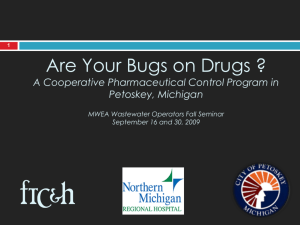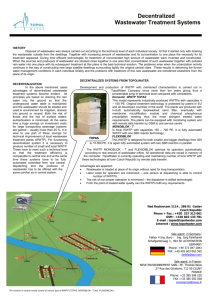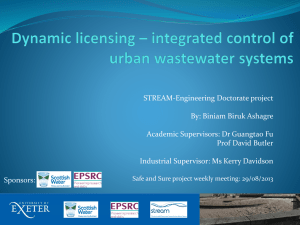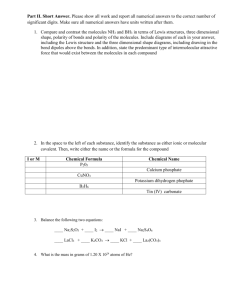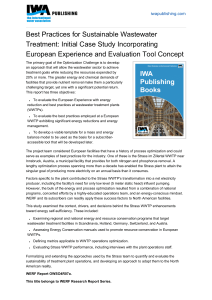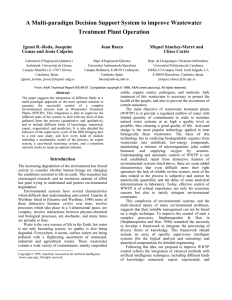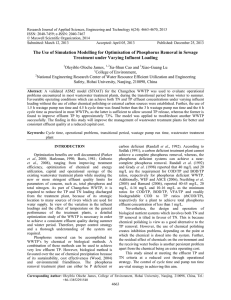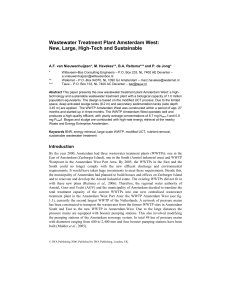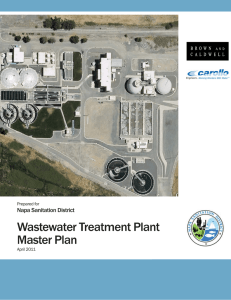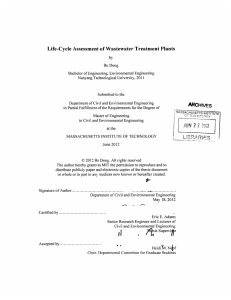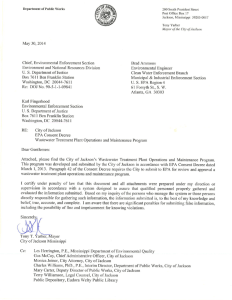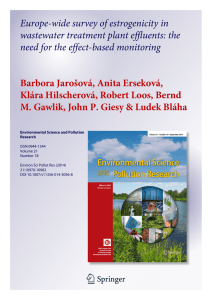Summit on Fraser River Sockeye Salmon Contaminants in sewage
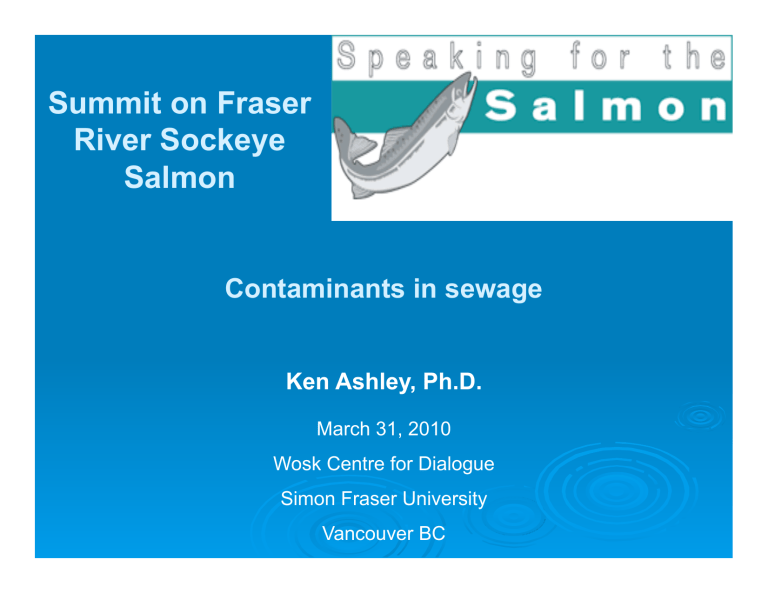
Summit on Fraser
River Sockeye
Salmon
Contaminants in sewage
Ken Ashley, Ph.D.
March 31, 2010
Wosk Centre for Dialogue
Simon Fraser University
Vancouver BC
Outline
Emerging concerns in wastewater
Silver nanoparticles from Samsung's SilverCare washing machine
will soon have to be registered with EPA as a pesticide.
For example: Triclosan
What are Endocrine Disruptors?
List of Identified Endocrine Disrupting
Chemicals (2007)
Removal efficiencies at WWTPs
Over half of the frequently detected EDCs
were reduced by 95% or more by Activated
Sludge plants
Less than 10% of the EDCs were reduced by
95% at the Trickling Filter plants
Primary treatment
Primary treatment is a mainly mechanical process that removes between 30 and 40 per cent of BOD and 50 per cent of the TSS.
Iona Island and Lions Gate Wastewater Treament Plants both provide primary treatment to the wastewater before the effluent - the remaining water - is released into the surrounding marine environment.
Secondary treatment
Secondary treatment is a biological process that removes up to
90 per cent of BOD and the TSS. Lulu Island, Annacis Island and
Northwest Langley Wastewater Treatment Plants provide secondary treatment to the wastewater before the effluent - the remaining water - is released into the Fraser River .
Removal efficiencies at WWTPs
Effect of WWTP design:
2007 study in England
Activated sludge WWTPs have higher removal efficiencies
for most EDCs than most trickling filter plants
Higher removal efficiency in AS WWTPs is due to (1) longer
hydraulic contact time (2) longer solids contact time and
(3) more diverse microbial community:
Activated Sludge WWTP ~ 5-20 hr HRT
Trickling Filter WWTP ~ 30 minute HRT
Biologically Aerated Filter ~ 15 – 60 minute HRT
Effect of WWTP design:
2007 USA study by Metcalf and Eddy Inc.
Highest (>90%) EDC removals were observed in:
AS plants with sludge age of 5 to 10 days and
AS plants with a nitrification/denitrification step
TF plants with additional tertiary biological step
Note: Annacis/Lulu design (TF/SC) is not effective at
removing EDCs (~ only 30% removal of estrone)
Effects on salmon migration?
In streams juvenile salmon detect the unique odour of their
natal streams – olfactory imprinting
This was confirmed by the classic morpholine experiments
of Hasler, and lab experiments or Hara.
Evidence suggests that juvenile salmon ‘imprint’ odours of
their streams on the way when the ocean during the parr
-smolt transformation period (PST).
During this period, they have elevated concentrations of the
hormone ‘thyroxine’ in their plasma
thyroxine is believed to regulate neurogensis, and surges of
hormones likely influence neural development in the salmon
olfactory system, and facilitate olfactory imprinting
PCB and PBDE trends in SoG sediment cores
Johannesen et al., 2008. Marine Environmental Research 66:S112-S120.
Tuesday, May 7, 2002
By ROBERT McCLURE
SEATTLE POST-INTELLIGENCER REPORTER
The orca found dead on the Olympic Peninsula earlier this year carried
a level of contaminants that was among the highest -- if not the
highest -- ever measured in killer whales, laboratory tests show.
The 22-foot-long female orca was so full of polychlorinated biphenyls
that when scientists first attempted to test her fat, the result was too
high for the machines to read it.
The Annacis STP discharges about 200,000 m3/d of primary-treated sewage to a portion of the Main Arm of the Fraser River where tidal influences exist. The tidal effects, in combination with projected effluent loadings, could result in impacts on river quality in the future at extremely low river flows. These impacts could be caused by copper, lead, zinc and un-ionized ammonia. Fecal coliform values are presently high outside the initial dilution zone. High metal and ammonia levels potentially could stress aquatic life, while high fecal coliforms could impair the use of the water for irrigation or recreation.
The Annacis Island Wastewater Treatment Plant (WWTP) is the
largest plant and provides secondary treatment to wastewater
from approximately 1,000,000 people in parts of Burnaby, New
Westminster, Port Moody, Port Coquitlam, Coquitlam, Pitt
Meadows, Maple Ridge, Surrey, Delta, White Rock, City of
Langley and Township of Langley.
Biosolids produced in 2006 (dry tonnes/24-34% solids
concentration): 12,000
Biosolids type: Class A
Solids digestion process: Anaerobic thermophilic (55°C)
pH 6 3,000:1 pH 7 300:1 pH 8 30:1 pH 9.5 1:1
Ammonia Toxicity
NH
3
< > NH
4
+
7 of 12 monthly
failures of 96 hr
LC
50
standard
bioassay tests for
ammonia in
effluent
Ammonia concentration in the Fraser River
(Flow 1 * Conc. 1) + (Flow 2 * Conc. 2 ) / Flow 1 + Flow 2)
For Fraser River in March, assume 1,500 m3/s, and 0.01 mg/L NH
3
For Annacis WWTP discharge in March = 469,000,000 L/d = 5.428 m3/s,
and 26.9 mg/L NH
3
(1,500,000 * 0.01) + (5,428 * 26.9) / (1,500,000 + 5,428) = 0.11 mg/L at pH 7.1
At 1,000 m 3 /s = 0.16 mg/L NH
3
At 2,000 m 3 /s = 0.08 mg/L NH
3
Table 4. Average 30-Day Concentration of Total Ammonia Nitrogen for
Protection of Aquatic Life (mg/L of Nitrogen) pH
6.5
6.6
6.7
7.0
7.1
6.8
6.9
7.2
7.3
7.4
7.5
7.6
T = 7.0
1.90
1.90
1.90
1.90
1.90
1.90
1.90
1.90
1.90
1.90
1.91
1.91
Temperature (T) in degrees Celcius
T = 8.0
T = 9.0
T = 10.0
T = 11.0
1.88
1.88
1.88
1.88
1.88
1.88
1.88
1.88
1.88
1.88
1.88
1.89
1.86
1.86
1.86
1.86
1.86
1.86
1.86
1.86
1.86
1.87
1.87
1.87
1.84
1.84
1.84
1.84
1.84
1.84
1.84
1.85
1.85
1.85
1.85
1.85
1.82
1.82
1.83
1.83
1.83
1.83
1.83
1.83
1.83
1.83
1.83
1.84
T = 12.0
1.81
1.81
1.81
1.81
1.81
1.81
1.81
1.81
1.82
1.82
1.82
1.82
T = 13.0
1.80
1.80
1.80
1.80
1.80
1.80
1.80
1.80
1.80
1.80
1.81
1.81

